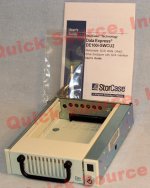Trash80toHP_Mini
NIGHT STALKER
I've been reading a bunch of threads about using server drives in our old Macs, so I've been looking around . . .
. . . If someone in the tech Support Brigade could contribute a howto on Server HDD types and adaptation aimed at the rest of us, it would be very helpful.
Ultra320 SCSI controller cards (some) appear to be backward compatible with SCSI 3 and SCSI 2 . . .
. . . which makes me wonder if the Ultra 320 drives would be backward compatible for earlier controllers as well . . .
. . . some are listed as "SAS, SCSI" . . . what's SAS?
So, would an Ultra320 SCSI adaptable to our toys?
__if so: how?
__if not: why?
________________________________________________________________________________________________________
Links to any previous threads about server drives would be appreciated and will be posted here in a revamped IP . . .
Problems, problems...Where do I begin?
SCSI Ultra 3 for older Mac
80 pin -> 50 pin SCSI adapter in SE/30
. . . If someone in the tech Support Brigade could contribute a howto on Server HDD types and adaptation aimed at the rest of us, it would be very helpful.
Ultra320 SCSI controller cards (some) appear to be backward compatible with SCSI 3 and SCSI 2 . . .
. . . which makes me wonder if the Ultra 320 drives would be backward compatible for earlier controllers as well . . .
. . . some are listed as "SAS, SCSI" . . . what's SAS?
So, would an Ultra320 SCSI adaptable to our toys?
__if so: how?
__if not: why?
________________________________________________________________________________________________________
Links to any previous threads about server drives would be appreciated and will be posted here in a revamped IP . . .
Problems, problems...Where do I begin?
SCSI Ultra 3 for older Mac
80 pin -> 50 pin SCSI adapter in SE/30


